#native bird photography
Photo
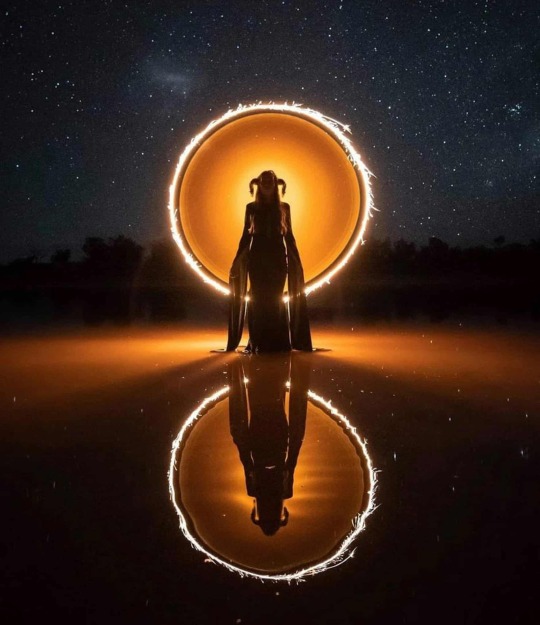
Blak Lens: emerging Aboriginal photographers join forces – in pictures
Mandy Smith is a Barkindji Woman born and raised in Mildura, Victoria. She specialises in Australian native bird photography, creative light painting, astrophotography and landscapes. ‘I wanted to create a dark and mystical image and incorporated the light painting into it,’ she says of this self-portrait. ‘It was taken on a salt flat’
#mandy smith#photographer#barkindji woman#mildura#victoria#australia#first nations#aboriginal#native bird photography#creative light painting#artist#art#astrophotography#landscapes#culture
35 notes
·
View notes
Text


cool magpie!!
599 notes
·
View notes
Text


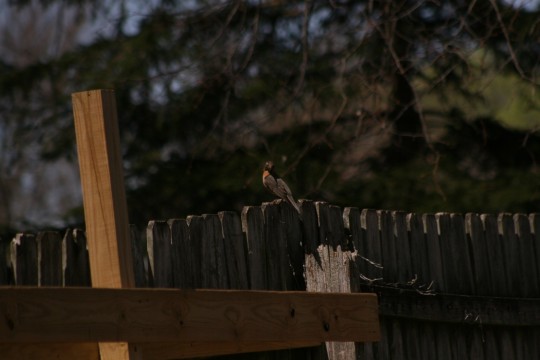
4.8.24
#photography#illinois#clinton illinois#april#2024#digital photography#animals#bird#birds#robin#robins#birding#bird watching#twin peaks#blue velvet#ndn artists on tumblr#native artists on tumblr#native american artists on tumblr#canon eos 30d#canonphotography#canon camera#canon photography#canon
45 notes
·
View notes
Text


Bird's Foot Violet
Viola pedata
Named after its leaves which resemble a bird's foot... This gorgeous violet is native to a large portion of eastern North America and thrives in sandy areas, rocky slopes, and other sunny, very well-drained habitats that are undisturbed. Three different color varieties can be found in the wild; bicolor (pictured above), lilac, and white. I have found both the bicolor and solid lilac varieties in abundance within glades and some prairies here in Missouri. Additionally, this species hosts fritillary butterfly larvae and provides nectar to many other butterflies and bees.
April 18th, 2024
St. Francois County, Missouri, USA
Olivia R. Myers
@oliviarosaline
#botany#plants#nature#viola#Viola pedata#violets#bird's foot violet#naturecore#flowers#the ozarks#ozarks#Missouri#hiking Missouri#Violaceae#wild flowers#wildflowers#native flowers#native plants#prairies#prairie#glades#purple flowers#violet flowers#purple#violet#pansies#pansy#fairycore#nature photography#flower photography
26 notes
·
View notes
Text
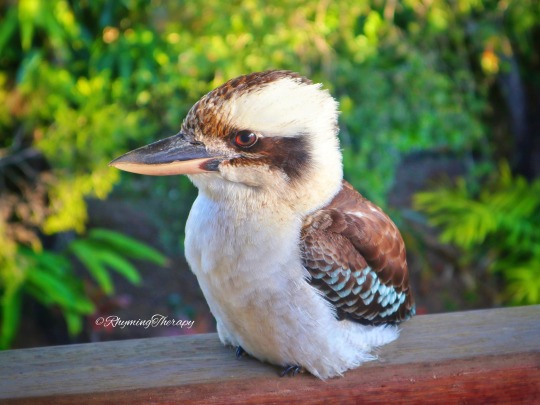



The kookaburra’s piercing amber eyes shone
fierce—with razor-sharp beak to hone
superior hunting skills; unflappable little one.
RhymingTherapy—August 2022 (my photos of a friendly visitor taken early August) @writerscreed challenge “diminishing poem”
#writerscreedchallenge#poeticstories#poetryportal#twcpoetry#nature#poets on tumblr#original photography#kookaburra#native bird#photographers on tumblr#my garden#Australia#birdlife
459 notes
·
View notes
Text


Kwak'Wanigaml (Heron Headdress), c. 1890
Herbert Johnson - (Gayusdisa'las) Kwakwaka'wakw, Kwikwasutinexw, Kingcome, d. 1953
Red cedar, nails, paint, 26 x 13 1/2 x 17 in.
Seattle Art Museum 91.1.31
"Solitary blue herons stand silently on coastlines and in wetlands perched on their thin legs. They wade slowly, sometimes point their head and beak skyward, and often seem as still as a statue. This object includes the sinuous neck and long beak of a heron but no legs beause the heron’s shape has been adapted to serve as a headdress. Stylized designs add a distinctive feature on the crest, wings, and tail. One can only imagine the striking vision of the heron striding into a ceremony atop the head of a leader who honors one of his crest animals."
Bonus:
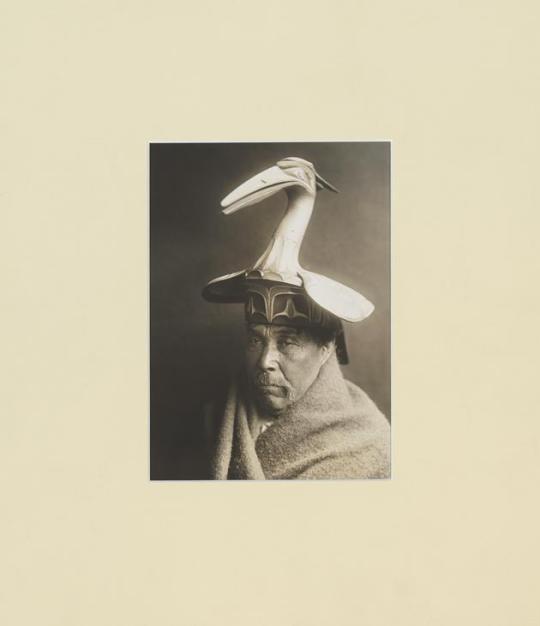
Man with Heron Hat, 1914
photo by Edward S. Curtis (American, 1868-1952)
Glossy silver print, 10 × 8 in. (25.4 × 20.3cm)
Seattle Art Museum
#Indigenous art#Native American art#First Nations art#birds in art#heron#bird#headdress#historical costume#Herbert Jphnson#Kwakwaka'wakw#19th century art#woodwork#Seattle Art Museum#hat#photography#ethnography#historical photography#Edward S. Curtis#American art#20th century art
30 notes
·
View notes
Text

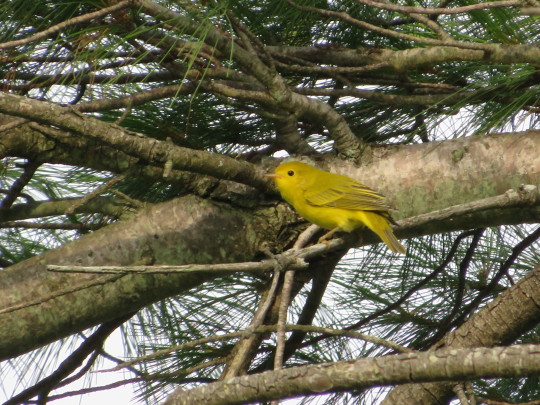
Setophaga petechia (northern female)
#yellow warbler#canada#my photos#native species#summer 2023#bird photography#birds#wildlife#nature photography#cottagecore
9 notes
·
View notes
Text



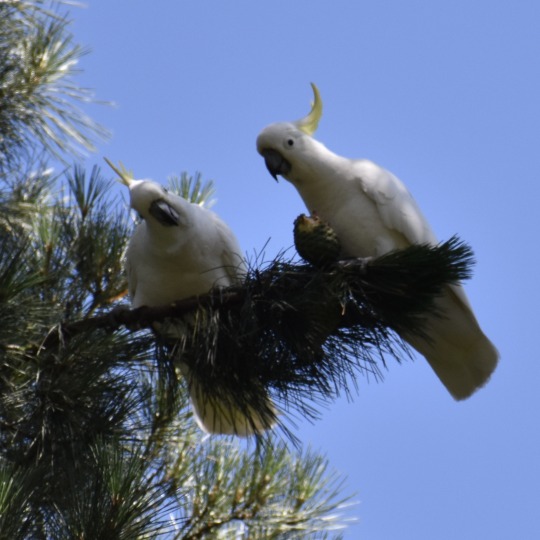

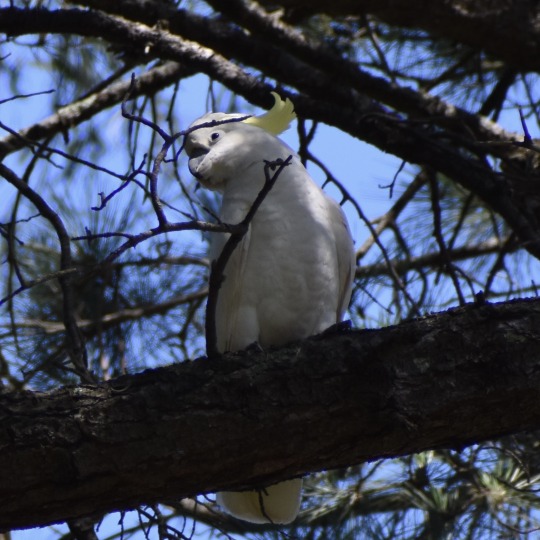




Pictures of birds in my backyard I took recently
17 notes
·
View notes
Text

A pair of locals coming up to say Good Morning! In Goolwa South, SA
#original photography#photographers on tumblr#australian photography#australian photographer#original photographer#south australia#travel photography#nature#original artist#Goolwa#Black swans#bird photography#native birds
11 notes
·
View notes
Text


Had this Kererū in my back yard for three and a half hours the other day, super confident, closest I’ve ever had one to me, I could’ve reached out and touched it while it was eating the berries at the end of my glass house. A beautiful experience.
#my photography#pp#kererū#native bird#wood pigeon#pigeon#New Zealand#Aotearoa#Otago#Ōtepoti#Dunedin#bird
15 notes
·
View notes
Text

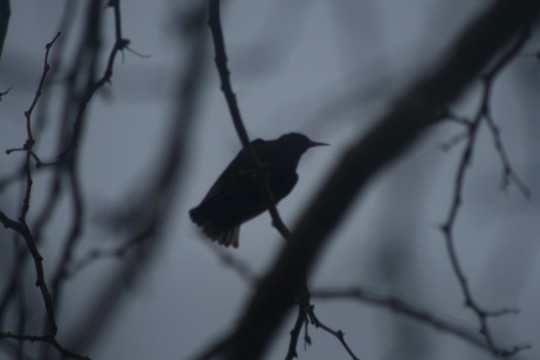
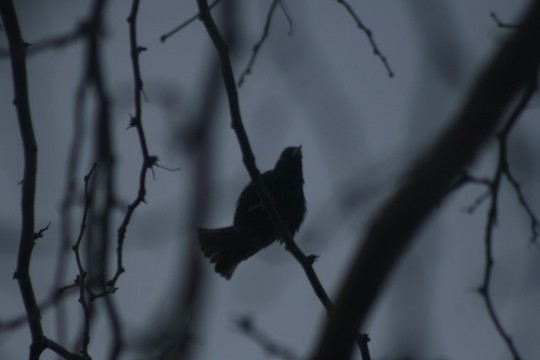


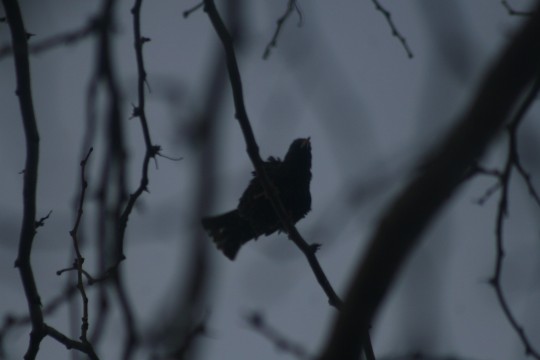
3.29.24
#photography#clinton illinois#illinois#digital photography#march 2024#march#2024#canon eos 30d#canonphotography#canon camera#canon photography#canon#birds#animals#bird#bird watching#birding#ndn artists on tumblr#native artists on tumblr#native american artists on tumblr
42 notes
·
View notes
Text



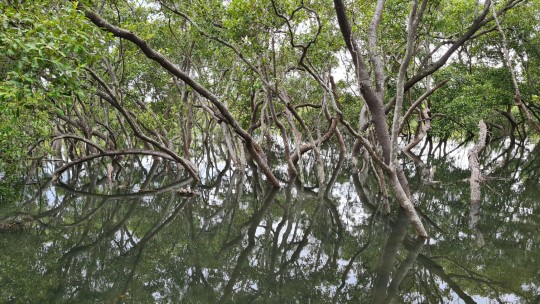
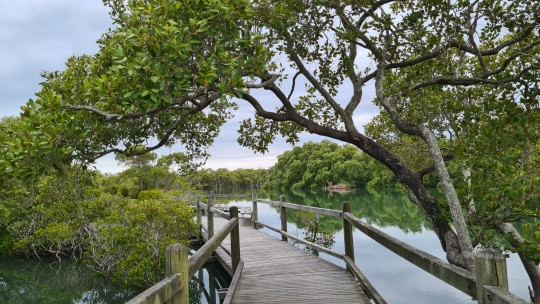
this is what the boondall wetlands directly next to the brisbane entertainment centre where those latest shows were looks like btw :) this was boxing day 2022 at what i believe must have been king tide <3
#see a lot of ppl complaining abt brisbane i wish i'd taken some of the visitors round here to check out the cool native birds & pretty bugs#also the dog's only off leash bc she's very well trained and also never wanders more than 10m ahead of us and is scared of water anyway lol#plus she's never shown any interest in chasing birds or animals. her sister however remains firmly on lead KSKSDKDKD#anywayyyy non-european/north american climates and ecosystems are beautiful even tho u never see them on tv!!!#my photography#*#**
46 notes
·
View notes
Text

Tui
174 notes
·
View notes
Text


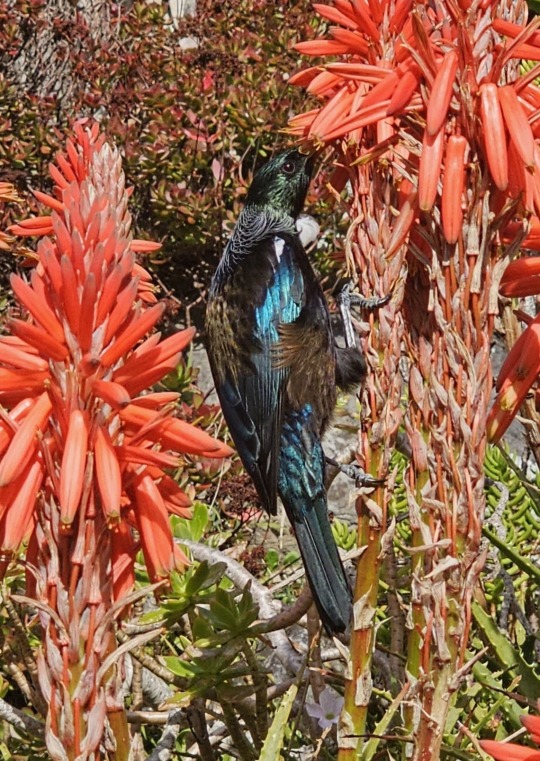

Tūī
Tūī | Parson Bird. Wellington Botanical Gardens. A large New Zealand honeyeater with irredecent plumage of black, green, purple and bronze.
White tufts at the throat inspired the European name 'Parsons Bird'. In te ao Māori Tūi are associated with life fulfillment, confidence, and spiritual harmony.
They are said to be messengers of the Gods.
5 notes
·
View notes
Text
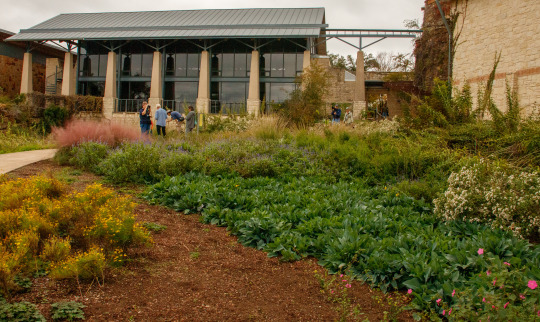
”Insects All Around Us” by Digital Edital Editor Kit O'Connell, originally published in the January/February 2024 issue of Texas Observer magazine:
Photography and additional reporting by Fall 2023 Reporting Fellow Paula Levihn-Coon.
The prey is already dying when the hunters arrive.
The sky is dark gray, the air thick with the threat of rain. But that hasn’t stopped over a dozen from gathering. They’re mostly, but not exclusively, older folks—frequently retirees with the ability to take a weekday morning off—and they’re armed with Digital SLR cameras and macro lenses.
Valerie Bugh crouches down over the squirming spots on the stone of the shady courtyard entrance to the Lady Bird Johnson Wildflower Center, prodding at the poisoned insects. Bugh, a gray-haired local naturalist, isn’t responsible for the state of these southern yellowjackets (Vespula squamosa), but she’ll take advantage of it for a photo opportunity. Someone on staff at the center discovered their nest and sprayed them just before the bug hunters arrived, and the entire hive is trickling out from their hidden home in a low rock wall. Bugh warns me to keep my distance from the females, who have fatter-looking bodies with stingers compared to the longer, thinner males, which normally only leave the nest for mating purposes. As I take a step back, she fearlessly kneels by their wriggling bodies, picking the males up and focusing her camera on each in turn.
“I’m trying to find one that doesn’t look dead,” she said. Soon, she’d even manage to document the hive’s queen as it haplessly tried to flee the toxins—a rare catch, though a grim beginning for a weekly ritual that largely focuses on the living.

Katherine Daniels and David Cook, volunteers, take insect photos.
Bugh is the author of 10 short fold-out pamphlets with color photos, with titles like Spiders of Texas: A Guide to Common and Notable Species and Unusual Insects of Texas: Caddisflies, Mantides, Lacewings, Walking Sticks, & More. That’s just one of her jobs: She’s also second clarinet in the Austin Opera. She’s modest about these accomplishments when asked—Bugh is too busy searching for bugs to brag about herself.
Every Thursday morning from February through mid-December, Bugh and her team of volunteers in the Lady Bird Johnson Wildflower Center Fauna Project explore a winding path, gradually aiming to cover the entire grounds over the course of a year, in order to inspect more than 650 species of native plants in the gardens and the 50-plus species of oaks in the Texas Arboretum for their occupants.
With this diversity of native plants comes a diversity in insect population too. Allowing for a few pandemic-imposed breaks and schedule changes, Bugh has otherwise been doing this consistently since 2010, during which time she’s identified almost 3,000 species of insect including over 50 bees, 345 flies, and over 500 different beetles. It’s not unusual to find a new species to add to the garden’s known tiny inhabitant list every week.
As Bugh gets moving, other bug hunters follow her in a pack. One by one and in pairs they break off from documenting spiders and beetles found clinging to the brick walls around the entrance and offices of the center. A few volunteer birders are also on-site, but for the most part, they work independently and seem invisible compared to the cheerful, chattering bug hunters. The group also documents signs of larger animals, from mammals to amphibians, but their main focus is on these tiny crawling creatures, since bugs are the most plentiful fauna present both in this garden and worldwide.

Every Thursday from 2010 to the present, Valerie Bugh leads the Fauna Project at the Lady Bird Johnson Wildflower Center in Austin, Texas.
The bug hunters move in a little cluster, calling out when they find something new for Bugh to examine. The salt marsh moth (Estigmene acrea) caterpillars are everywhere.
“If it’s a salt marsh, I don’t want to know about it,” declares Bugh dismissively, though with good humor. Their hairy bodies remind me of an asp, the caterpillar with a nasty sting. But they’re actually harmless to the touch. Bugh is just frustrated because there are too many of them. Unlike other caterpillars, the salt marsh moths will eat almost any plant, building its hairy cocoons all over.
“Every single plant is their host,” Bugh said.
By contrast, the Gulf fritillary (Agraulis vanillae), another caterpillar present in the day’s fauna count, subsists almost entirely on passion flower vines.
Bugh’s disdain for the salt marsh moth doesn’t stop her from plucking one from the greenery and posing for a photo with it. She’s happy to show off and talk about her fauna friends, even the overly common ones. As she moves around, her tone becomes more of a graduate lecture in entomology, no doubt similar to the insect walks she sometimes leads around Austin. Her volunteers are here to hone their skills at macro photography, to learn from a preeminent local expert, and to expand their naturalist knowledge. Many are members of the Texas Master Naturalist program.
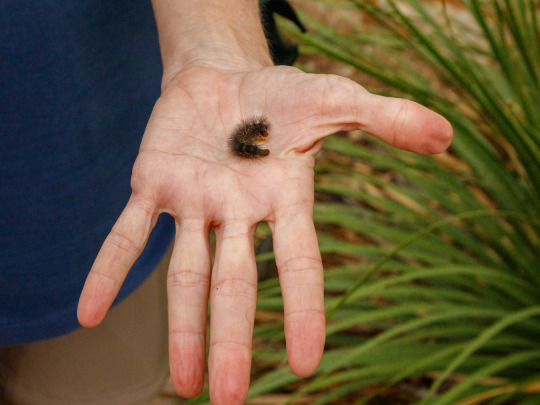
Valerie Bugh holds a salt marsh moth caterpillar (Estigmene acrea) in her hand.
But it’s a social occasion as much as anything, and the bug hunters talk among themselves around me, catching up on their lives. Two have just returned from African vacations and are excited to dish about all the great wildlife photos they got there, documenting large predatory wild beasts. But they seem just as eager to capture the living world’s small inhabitants in their lenses, too.
“It’s an insect safari,” said volunteer Katherine Baker, who told me she relished the challenge of macro photography after over a decade of experience in more general nature photography. She’s been helping count the fauna for about four years now, and always feels among kindred spirits here. But they all orbit around Valerie, returning to her for advice or an ID after wandering off.

Every Thursday for 13 years, naturalist and author Valerie Bugh, far left, has led volunteers in counting and photographing animals at the
wildflower center.
“Her knowledge surpasses everyone … she’s just amazing,” Baker said of Bugh.
The gray morning clouds are starting to burn off. As it warms up, the butterflies and others will begin to emerge from the foliage where they’re resting during the rainy, humid part of the day.
“Aha, here’s where the bumblebees are,” Bugh declares with delight as some are pointed out to her. “These are workers and look how docile they are, they’re barely moving.”
Even before the sun appears, I become aware of how the plants around us are full of life, more than first appears to the untuned eye. As I start looking at one insect, like the predatory leafhopper assassin bug (Zelus renardii), a leggy, long-bodied, hungry thing with a venomous proboscis, I spot another, smaller bug crawling along the same bit of wild grass. We allow ourselves to forget in our day-to-day lives, but insects are all over, constantly surrounding and outnumbering us.
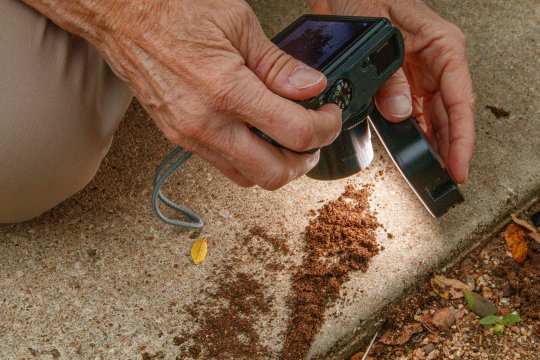
Valerie Bugh shines a small LED light on an insect.
On the day we visited, the team spotted seven different kinds of grasshoppers, two types of katydids and one cricket. Hunters often spot the American bumblebee, Bombus pensylvanicus, which is thriving in Central Texas even as its numbers dwindle elsewhere. But lately, its Sonoran cousin (Bombus sonorus) has been showing up more and more in the bug counts.
“That doesn’t bode well for desertification,” Bugh told me. “We’ve had a lot of Western species moving in, birds too, which means the habitat is great for them and a little drier than we’re used to for everyone else.”
The naturalist bug hunters are strongly aware of the harm climate change has brought on our region, and there’s a bittersweet feeling to parts of the morning, a subtle sense that someday soon could be the last day one of these fauna appear in a count.
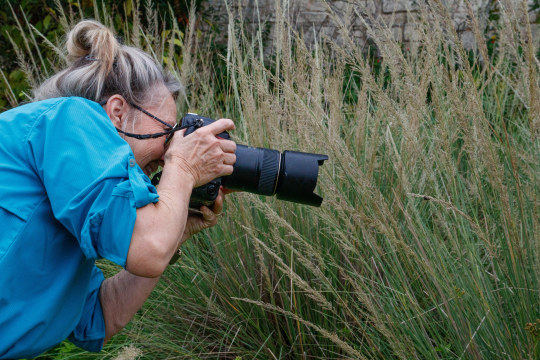
“The ecosystems are moving east, including tornado alley. It’s not great for the people in the way, and not great for us on the edge of deserts. Think of Austin without any trees. I really like trees,” Bugh says wistfully.
But most insects still spark joy when she spots them. As sure as falling leaves, the appearance of the scorpion flies (which are neither scorpions nor flies) represents the start of true Texas autumn, and they were just putting in their first appearances that Thursday in November.

Bugh can identify a great number of creatures on sight, but sometimes enlists help from collaborative internet forums and apps, or even, in one case, a book of Central American insects published in 1900.
Later, when I come home from the center, I pore over her very detailed homepage, which features a searchable spreadsheet of every creature identified by her team since 2010. I email Bugh to ask what changes she’s noticed over time.
“It is very hard to compare the past to the present since it is short term in geological time but very long term for humans,” she writes back. “Who can say what they’ve learned in over a decade? I bet it is a lot.”
#Austin#Texas#wildflowers#native plants#lady bird johnson#bugs#insects#photography#macro photography#wildlife#wildlife photography#fauna#science#entymology
2 notes
·
View notes